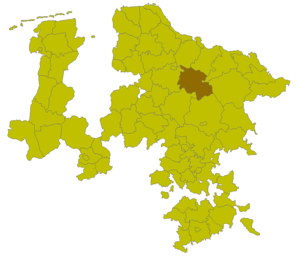District of Soltau
| coat of arms | Germany map | |
|---|---|---|

|
Coordinates: 52 ° 59 ' N , 9 ° 51' E |
|
| Basic data (as of 1977) | ||
| Existing period: | 1885-1977 | |
| State : | Lower Saxony | |
| Administrative region : | Luneburg | |
| Administrative headquarters : | Soltau | |
| Area : | 962.7 km 2 | |
| Residents: | 66,000 (Jun 30, 1977) | |
| Population density : | 69 inhabitants per km 2 | |
| License plate : | SOL | |
| Circle key : | 03 3 38 | |
| Circle structure: | 6 municipalities | |
The district of Soltau was a district in Lower Saxony until 1977 .
geography
At the beginning of 1977 the district bordered clockwise in the north, beginning with the districts of Harburg , Lüneburg , Uelzen , Celle , Fallingbostel and Rotenburg (Wümme) .
history
| Location of the district of Soltau in the province of Hanover (1905) |
|
|---|---|

|
The district of Soltau was formed from the Office of Soltau in 1885 . The seat of the district administration was in the city of Soltau. From October 1, 1932 to October 1, 1933, the districts of Fallingbostel and Soltau were temporarily merged under the name of the Fallingbostel district. On August 1, 1938, the Bockel community was reclassified from the Fallingbostel district to the Soltau district.
The regional reform in Lower Saxony began in the Soltau district on February 1, 1971, when Alvern , Ilster , Oerrel , Töpingen and Trauen were incorporated into the city of Munster . On July 1, 1972, Breloh and the community of Lopau from the Uelzen district were also incorporated into the city of Munster. Numerous communities in the district were merged in March 1974 through the law on the reorganization of the communities in the Soltau / Fallingbostel area and the ordinance on the reorganization of the Bispingen community. The municipality of Woltem also came from the Fallingbostel district to the city of Soltau . Overall, the regional reform reduced the number of municipalities in the district from 58 in 1970 to six in 1974.
During the district reform in Lower Saxony, the district became part of the Soltau-Fallingbostel district on August 1, 1977 together with the Fallingbostel district, which has been called the Heidekreis district since August 1, 2011 .
Population development
|
|
District administrators
- 1885–1888 Carl Wellenkamp
- 1888–1889 Karl von Marcard
- 1889–1901 Wilhelm Heinichen
- 1901–1907 Carl Ludwig Kleine
- 1907–1925 Axel von Rappard
- 1925–1933 Johann Justus Duvigneau
- 1933–1944 Paul von Hodenberg
- 1944–? Hans Waldow Ritzler in Harburg (substitute)
- 1945–1946 Heinrich Marquardt
- 1948–? Walter Möhlmann ( DP )
- 1964–1977 Wolfgang Buhr ( CDU )
Communities
The following list contains all municipalities that have ever belonged to the Soltau district, as well as all incorporations:
Until its dissolution in the 1920s, the district of Soltau also had the uninhabited forest districts of Druhwald and Wintermoor.
License Plate
On July 1, 1956, the district was assigned the distinctive symbol SOL when the vehicle registration number that is still valid today was introduced . It was issued until April 4, 1978.
Individual evidence
- ^ District regulation for the province of Hanover (1884)
- ^ Law on the expansion of the city of Munster, January 25, 1971
- ↑ Law on the reorganization of the communities in the Uelzen area and in the area of the city of Munster, May 10, 1972
- ^ Federal Statistical Office (ed.): Historical municipality directory for the Federal Republic of Germany. Name, border and key number changes in municipalities, counties and administrative districts from May 27, 1970 to December 31, 1982 . W. Kohlhammer, Stuttgart / Mainz 1983, ISBN 3-17-003263-1 , p. 236 .
- ↑ Statistical Yearbook for the Federal Republic of Germany 1978
- ^ The protocols of the Prussian State Ministry , Vol. 12 / II, p. 552
- ^ Municipal directory 1910: District of Soltau
- ↑ territorial.de: District of Soltau
- ^ Michael Rademacher: German administrative history from the unification of the empire in 1871 to the reunification in 1990. soltau.html. (Online material for the dissertation, Osnabrück 2006).
- ↑ Lower Saxony State Administration Office (ed.): Municipal statistics of Lower Saxony 1960/61. Part 1: Population and Employment, Hanover 1964, pp. 158–164.

